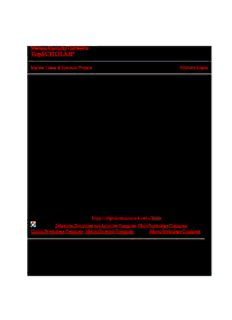Table Of ContentWestern Kentucky University
TopSCHOLAR®
Masters Theses & Specialist Projects Graduate School
Spring 2018
Practice Standards for Initial ADHD Assessment: A
Review
Lauren Spencer
Western Kentucky University, [email protected]
Follow this and additional works at:https://digitalcommons.wku.edu/theses
Part of theBehavioral Disciplines and Activities Commons,Child Psychology Commons,
Clinical Psychology Commons,Mental Disorders Commons, and theSchool Psychology Commons
Recommended Citation
Spencer, Lauren, "Practice Standards for Initial ADHD Assessment: A Review" (2018).Masters Theses & Specialist Projects.Paper 2338.
https://digitalcommons.wku.edu/theses/2338
This Thesis is brought to you for free and open access by TopSCHOLAR®. It has been accepted for inclusion in Masters Theses & Specialist Projects by
an authorized administrator of TopSCHOLAR®. For more information, please contact [email protected].
PRACTICE STANDARDS FOR INITIAL ADHD ASSESSMENT: A REVIEW
A Thesis
Presented to
The Faculty of the Department of Psychology
Western Kentucky University
Bowling Green, Kentucky
In Partial Fulfillment
Of the Requirements for the Degree
Master of Arts
By
Lauren Whitney Spencer
May 2018
ACKNOWLEDGEMENTS
I would like to acknowledge the incredible amount of guidance my thesis director, Dr.
Farmer, contributed to this project. I would like to thank him for agreeing to chair this
project even when he had 9000 other things to do. He contributed so much to my success
in this program, and has been an inspiration both personally and professionally. I would
also like to thank my committee members, Dr. Myers and Dr. McBride, for their time
spent on helping me perfect this project. Lastly, I would like to thank my cohort, my
boyfriend Ryan, and our sweet fur son Kai for their undying support during this time.
CONTENTS
LIST OF FIGURES ........................................................................................................... vi
LIST OF TABLES ............................................................................................................ vii
Abstract………………………………………………………………………………….viii
Introduction………………………………………………………………………………..1
Negative Impacts of ADHD on the Child ....................................................................... 1
Prevalence and Etiology .................................................................................................. 2
Diagnostic Criteria .......................................................................................................... 4
Challenges to Correct Diagnosis ..................................................................................... 8
Evidence-Based Assessment of ADHD ........................................................................ 14
Established Practice Guidelines .................................................................................... 16
Purpose of this Review .................................................................................................. 21
Methods............................................................................................................................. 23
Results ............................................................................................................................... 25
Measures........................................................................................................................ 26
Differential Diagnosis ................................................................................................... 56
Construct Irrelevant Influences ..................................................................................... 60
Best Practice and Decision-Making Models ................................................................. 64
Discussion ......................................................................................................................... 71
Limitations .................................................................................................................... 75
Directions for Future Research ..................................................................................... 76
Conclusion ..................................................................................................................... 77
References ......................................................................................................................... 78
iv
APPENDIX: Best Practice Guidelines for ADHD Diagnosis………………………….101
v
LIST OF FIGURES
Figure 1. Inclusion and exclusion criteria………………………………………………..25
vi
LIST OF TABLES
Table 1. Comparison of DSM-5 and ICD-10 (2017) criteria………...…………..……......7
vii
PRACTICE STANDARDS FOR INITIAL ADHD ASSESSMENT: A REVIEW
Lauren Spencer May 2018 102 Pages
Directed by: Dr. Ryan Farmer, Ph.D; Dr. Carl Myers, Ph.D; Dr. Daniel McBride, Ph.D
Department of Psychology Western Kentucky University
There are many challenges that come with diagnosing attention-
deficit/hyperactivity disorder (ADHD), including shared symptoms with many similar
disorders, high comorbidity of other mental disorders, and subjective bias from informant
reports. Three clinical guidelines for diagnosing ADHD currently exist, published by the
American Academy of Pediatrics (AAP), the National Institute for Health and Care
Excellence (NICE), and the American Academy of Child and Adolescent Psychiatry
(AACAP). However, these guidelines are outdated as they are based on the Diagnostic
and Statistical Manual of Mental Disorders, Fourth Edition (DSM-IV) and do not
include more recent research. This project was intended to update these guidelines by
incorporating the Diagnostic and Statistical Manual of Mental Disorders, 5th Edition
(DSM-5) as well as a selection of research on ADHD diagnosis published in the last ten
years. This updated set of guidelines can be found in Appendix A of this document.
Emphasis is on the evidence-based assessment model of using only psychometrically
strong assessment measures and basing diagnostic decisions on posterior probabilities.
Review of the literature also indicated a need to assess for differential and comorbid
diagnoses in ADHD evaluations. Recommendations for doing so are discussed. Lastly,
results of the review provided a strong argument against the use of continuous
performance tests (CPTs) and other executive functioning measures in diagnosing
ADHD, as their diagnostic accuracy is generally not acceptable.
viii
Introduction
Roughly 10% of children ages 4 through 17 were diagnosed with attention-
deficit/hyperactivity disorder (ADHD) in 2011 and through 2013, making ADHD the
most common childhood neurodevelopmental disorder in the United States (Pastor,
Reuben, Duran, & Hawkins, 2015). Pooled estimates across 172 studies suggest that the
prevalence of ADHD in children under 18 is 7.2%, meaning that approximately 129
million children worldwide have ADHD (Thomas, Sanders, Doust, Beller, & Glasziou,
2015). Adding to its detriment, ADHD tends to have lifelong implications (Barbaresi et
al., 2013; Ingram, Hechtman, & Morgenstem, 1999; Shaw et al., 2012). However,
evidence shows that early intervention can reduce negative outcomes; therefore, it is
essential that children with ADHD begin treatment as early as possible (Delavarian,
Towhidkhah, Dibajnia, & Gharibzadeh, 2012; Shaw et al., 2012).
Negative Impacts of ADHD on the Child
Living with ADHD poses many challenges. Children with ADHD often face
functional impairment in a wide range of areas, including academics, social life, motor
control, and emotional regulation (Mash & Barkley, 2003). Children with ADHD score
significantly lower than non-ADHD peers on academic achievement tests as early as
preschool (Mash & Barkley, 2003). Having ADHD is associated with increased conflict
with parents, teachers, and peers. It is also associated with social rejection and having
very few friends (Mash & Barkley, 2003). In addition to functional impairments, parents
of children with ADHD consistently rate their children as having lower quality of life
than the average child (Danckaerts et al., 2010).
1
Description:essential that children with ADHD begin treatment as early as possible .. Specifically, good internal consistency reliability was defined as α values .. chosen was on initial diagnosis in children and adolescents, excluding articles

